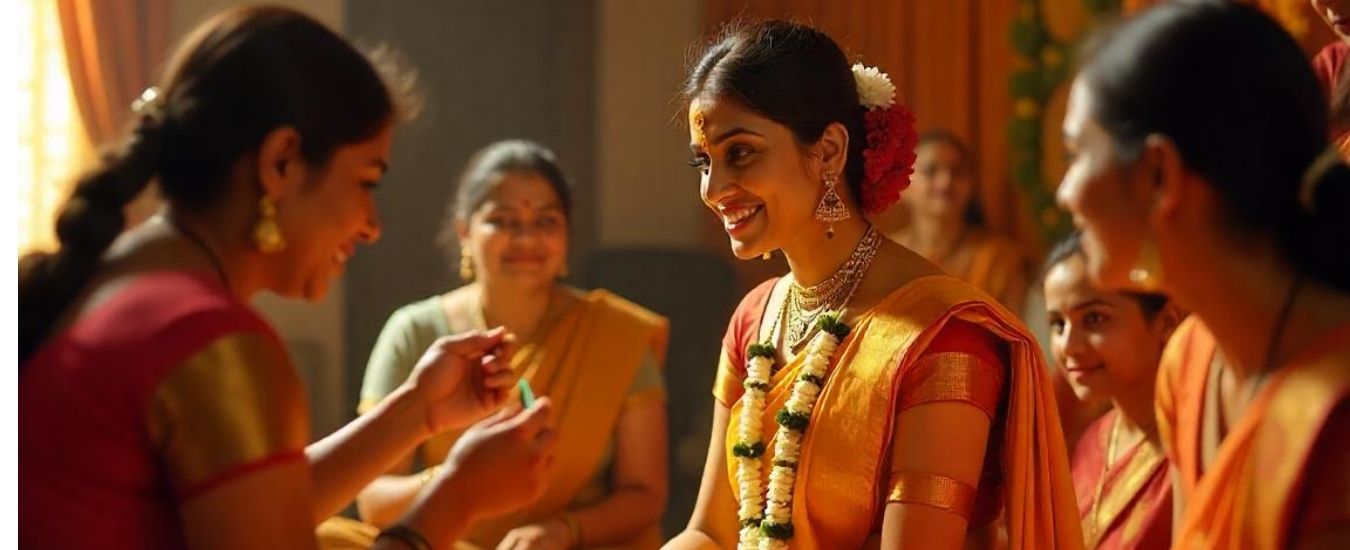Maratha weddings are a beautiful blend of tradition, spirituality, family bonding, and cultural richness. They’re not just events; they’re soulful journeys stitched with memories, colours, and legacy. Whether you’re a part of it or just witnessing it, one thing’s for sure.
Let us walk away with Aagrah Banquet with a full heart (and probably a fuller stomach!).
Groom’s Arrival – Baaraat Maratha Style
With dhols, shehnais, and lots of dancing, the groom arrives in style—often on a horse or in a decked-up car. He wears a Pheta (turban), a Kurta-Dhoti or Sherwani, and carries a traditional sword, symbolizing his warrior heritage. The Mangalashtak is sung in the background to bless the moment.
Seeman Puja – Welcoming the Groom’s Party
At the entrance, the bride’s family performs a Seeman Puja, welcoming the groom and his relatives with aarti, kumkum, and garlands. The Ganesh Puja is also conducted for an auspicious start. This is where the warmth of Indian hospitality shines.
Antarpaat – The Sacred Curtain Ritual
A white cloth called the Antarpat (अंतरपाट) is held between the bride and groom as the pandit chants Vedic mantras. Once the curtain is dropped, they see each other for the first time as husband and wife—a goosebump-worthy moment steeped in spiritual symbolism.
Saptapadi – The Seven Sacred Steps
The couple takes seven steps around the Agni (sacred fire), each representing a vow of dharma, prosperity, love, health, children, harmony, and friendship. These vows are the soul of the Shubh Mangal ceremony.
Kanyadaan – The Sacred Gift of the Bride
In this emotional ceremony, the bride’s father performs Kanyadaan, offering his daughter’s hand in marriage with trust and blessings. The ritual includes Sankalp and Tali Bandhan (Mangalsutra tying)—symbolizing an eternal spiritual union.
Post- Maratha Marriage Traditions
Grihapravesh – Welcoming the Bride Home
As the bride steps into her new home, she kicks over a pot of rice—a symbolic act of inviting prosperity and abundance. Her feet are dipped in kumkum, leaving red footprints as a sign of Lakshmi’s arrival.
Pag Pujan – Honoring the Bride’s Entry
The groom’s family washes the bride’s feet in a ritual called Pag Pujan, honouring her as Goddess Lakshmi. Sometimes accompanied by Ukhana recitation, it’s a moment of love and acceptance.
Reception – Celebrations and Feasting
A grand reception follows Maharashtrian delicacies like Puran Poli, Masale Bhaat, Batata Bhaji, and Modaks. The event includes music, dance, and blessings from extended family—a perfect blend of ritual and revelry.
Symbolism and Significance of Maratha Marriage Rituals
Spiritual Aspects
Every ritual is embedded in Vedic philosophy and Hindu dharma. From Punyavachan to mantra chanting, they align the couple’s union with cosmic energies and divine will.
Social and Cultural Values
Maratha weddings reflect community unity, respect for elders, and shared celebration. Mundavalya (pearl forehead bands) signify readiness and equality in marriage roles.
The Role of Family and Community
From matchmaking to organizing each ritual, the extended family and often the neighbourhood join hands. It’s a collaborative affair, with every task woven into tradition.
Modern Touches in Traditional Maratha Marriage
Fusion of Old and New
Modern couples customize their weddings with theme-based decor, personal vows, and even pre-wedding shoots—yet maintain traditions like Halad and Mangalashtak.
Destination Weddings and Designer Lehengas
Be it a royal palace in Rajasthan or a Goa beach, weddings now include designer Paithanis, statement jewellery, and wedding planners. Style meets sanctity.
Still Rooted in Rituals
Despite trends, rituals like the Haldi ceremony, Saptapadi, and Kanyadaan remain sacred. These timeless traditions hold the soul of the ceremony.
FAQs
What is the duration of a typical Maratha wedding?
Typically, it lasts 2 to 3 days, including Haldi, Ganesh Puja, the main wedding, and the reception.
Are Maratha wedding rituals similar to Maharashtrian weddings?
Yes, but with distinct community-specific traditions like Seeman Puja, Antarpaat, and Pag Pujan that define Maratha’s identity.
What attire do Maratha brides and grooms wear?
Brides wear Paithani sarees, nath, green bangles, and Mundavalya; grooms wear Dhoti-Kurta and Pheta and carry a sword.
Is dowry practised in Maratha weddings?
Dowry is traditionally discouraged. Instead, families exchange symbolic gifts emphasizing respect and equality.
What dishes are served at a Maratha wedding feast?
Expect Masale Bhaat, Puran Poli, Modak, Batata Bhaji, and Kharwas—served with affection and endless refills!
